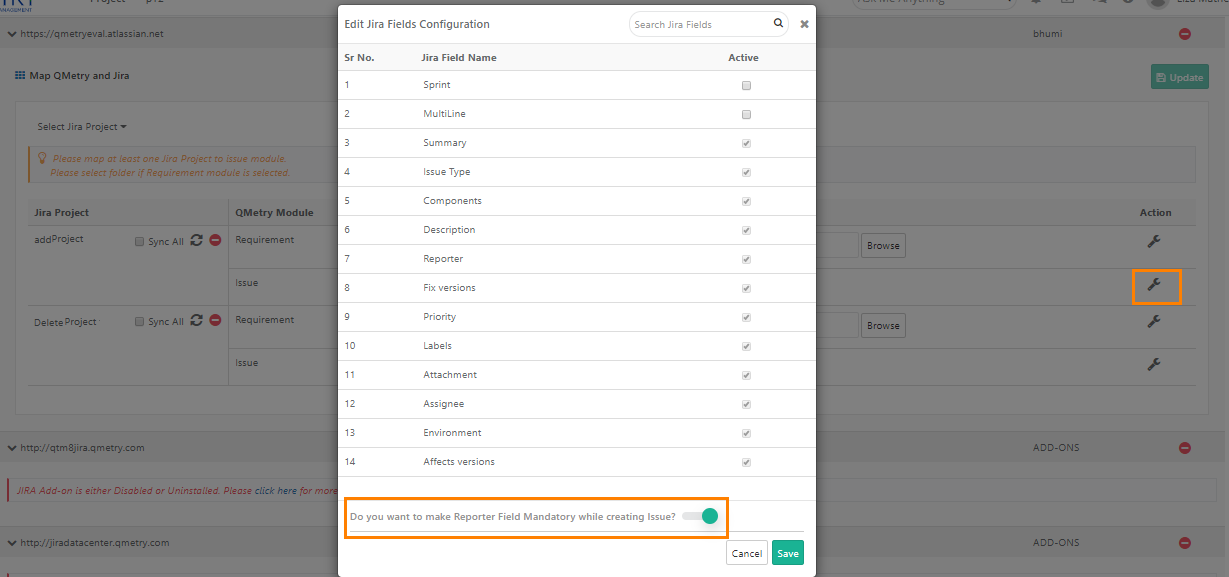
Map Jira Project with QMetry Project
Map Single Jira Project with QMetry Project
These steps have to be performed in QMetry by Login as QMetry Project Admin :
- Go to Projects > Project/Release/Cycle
- Open the Project > Jira Integration tab.
- Select the Jira URL with which this QMetry project mapping has to be done.
- Select the Jira project to configure with this QMetry Project.
- Once the Project is selected, select Issue Type <> QMetry Module associations. The issue type is a multi-select list. If requirement is mapped, select folder to import requirements.
- Click on Save and Activate.

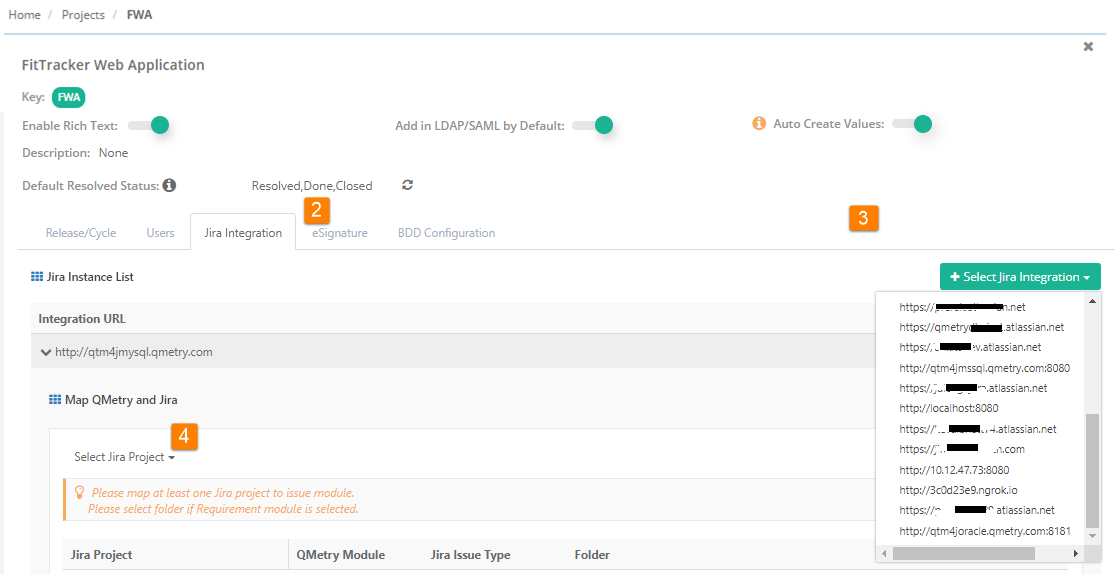
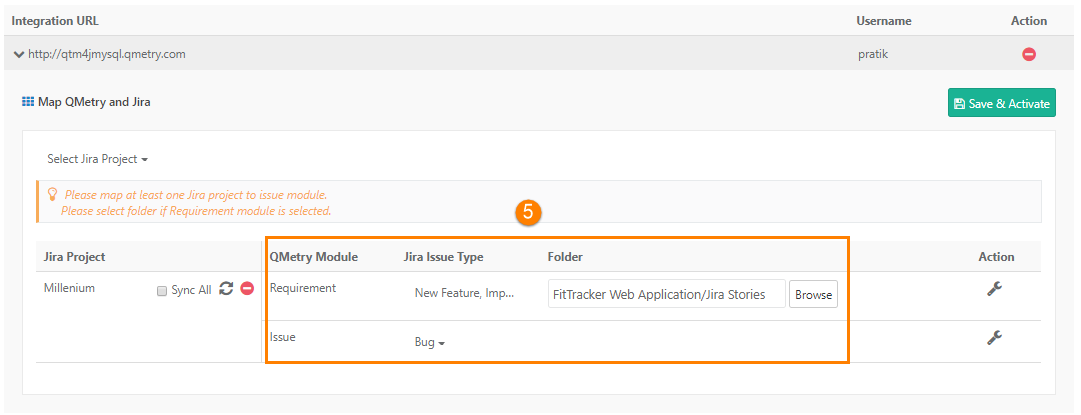
Map multiple Jira projects from a single Jira instance with one QMetry project
QMetry 8.5 allows multiple Jira projects to be configured with one QMetry project. Below are the steps for the same :
- Go to Projects > Project/Release/Cycle
- Open the Project > Jira Integration tab.
- Select the Jira URL with which this QMetry project configuration has to be done.
- Select the Jira project to configure with QMetry Project.
- Once the Project is selected, select Issue Type <> QMetry Module associations. The issue type is a multi-select list. If requirement is mapped, select folder to import requirements.
- Once the Jira Project is configured select another Jira project from the list and configure it the same way. This way you can select multiple Jira projects to integrate with one QMetry project.
- Click on Save and Activate. ("Update" if Jira integration was already Saved and Activated for the QMetry project.)

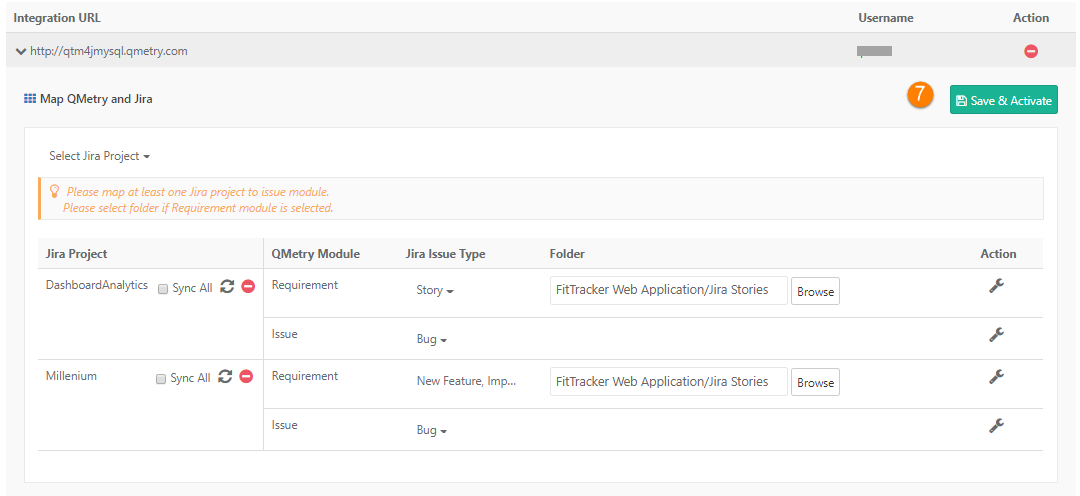
Map multiple Jira projects from multiple Jira instance with one QMetry project
QMetry 8.5 allows multiple Jira instances to be configured with one QMetry project. Below are the steps for the same:
- Go to Projects > Project/Release/Cycle
- Open the Project > Jira Integration tab.
- Select the Jira URL with which this QMetry project configuration has to be done.
- Configure the projects > Save and Activate the Integration.
- Once the Project is selected, select Issue Type <> QMetry Module associations. The issue type is a multi-select list. If requirement is mapped, select folder to import requirements.
- Select another Jira URL from the Jira Integration list.
- Configure the projects > Save and Activate the integration.
- Once the Project is selected, select Issue Type <> QMetry Module associations. The issue type is a multi-select list. If requirement is mapped, select folder to import requirements.
- This way you can integrate multiple Jira instances with QMetry Project.
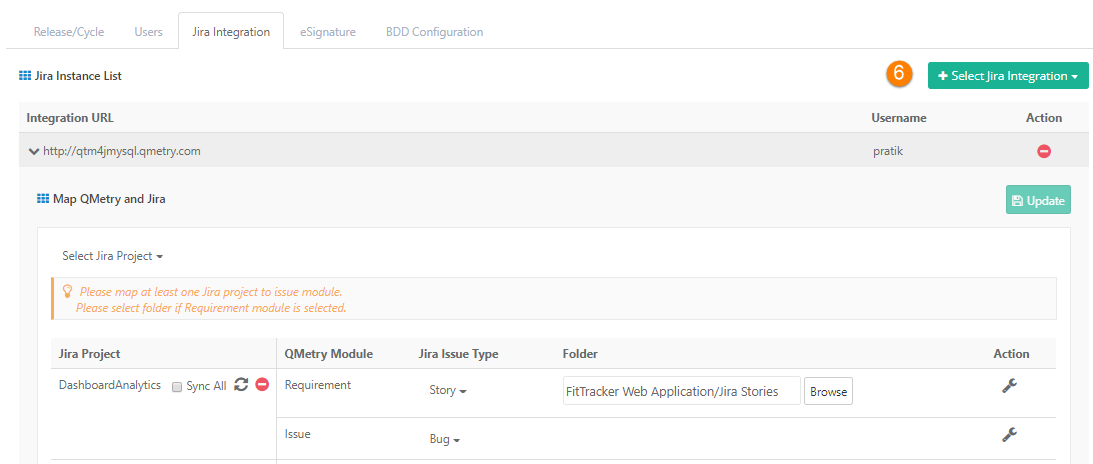
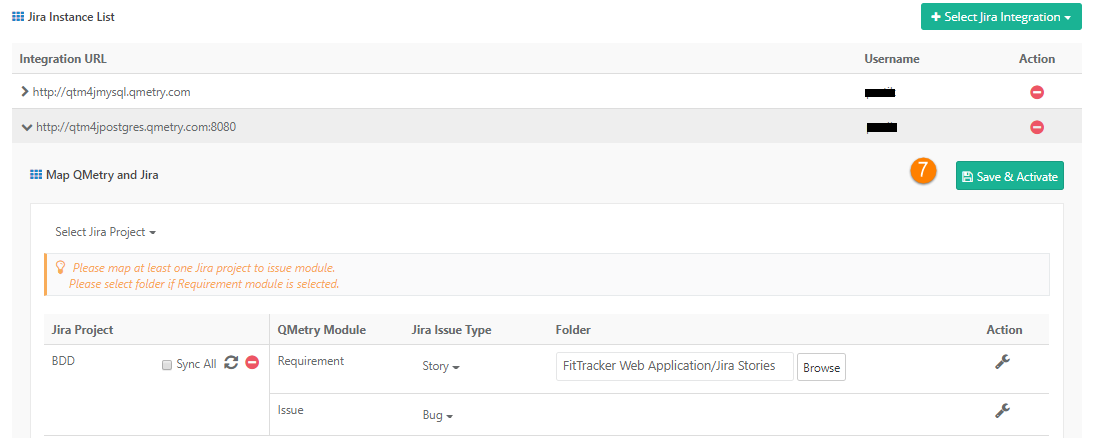
Map Jira issue type "Epic" with QMetry Requirement/Issue
QMetry supports mapping of "Epic" issue type when integrating Jira project with QMetry project. Users can import Epic issues of Jira as requirements or issues in QMetry and sync those issues.
- While integrating Jira with QMetry, Jira Issue Type "Epic" can be synced either with Requirement or Issue.
- While mapping fields, the Epic Name field should be marked as Active.
- While syncing, the "Epic Name" field will be synced for the Epic issue type and rest of the fields like "Fixed Version", "Affected Version", "Description" etc. will be synced in same way as it is in case of "Story" or "Bug" issue types.
If Epic is imported as requirements in QMetry -
- If Story and Epic both Issue types are synced with Requirement, the Epic imported as requirement will display the Epic Name on the requirement details page while the Story imported as requirement will display the Epic Name field blank.
- The Epic issue type will be available on Filters.
If Epic is imported as issues in QMetry -
- If Epic is synced with Issue, the Epic issues will be available while logging bugs.
- "Affected Version" in Jira Fields is available only for the "Bug" Type.
- "Epic Name" in Jira Fields is available only for the "Epic" type during creation of issue from execution screen.
- The Epic issue type will be available on Filters.
Known Issues:
- If "Epic" and "Story" are configured with QMetry, the Epic Fields like "Epic Name" will not be displayed in the Create Issue screen for Story.
Map QMetry Folder to Import Requirements
Project Admin has to select a folder during Jira configuration to import requirements from Jira into QMetry. QMetry v8.5.1 on wards, it is mandatory to select a folder for requirement while Jira integration.
Users who were using QMetry v8.5 or below, requirements from Jira were imported in the Imported folder in QMetry by default. QMetry v8.5.1 on wards, Project Admin has to select a folder of their preference to import requirements in QMetry. Requirements already imported earlier will remain intact in their respective folders. New requirements will be imported in the folder selected during Jira configuration.

If the user changes already set folder, then a pop-up appears asking confirmation on changing the destination folder for new requirements that are being imported. The impact will be -
- Only new requirements will be moved to synced folder.
- Requirements imported earlier will remain in their assigned folder only.
Copy / Move the Synced Folder
- On Copy/Move Folder, it will move folder to new folder and update folder mapping on the Project screen as well.
Archive Folder
- Folders with external entities in it can not be archived. User can move the imported requirements to other folder and then can archive the folder.
- The folder that synced during Jira integration for import of requirements can not be archived.
- In bulk archive folder, the folders having external entity will be skipped. Sub-folders of this folder will also be skipped from bulk archive even they do not have external entities in them.
Change Mapping of Issue Type with Requirement module
Scenario 1. Issue Type mapped with Requirement is replaced with another Issue Type
Issues synced based on the earlier mapping will be converted into internal issues and they will no more be Jira issues.
New issues will be synced as requirements as per the changed Issue Type.
Scenario 2. In addition to existing Issue Type, another Issue Type is mapped with Requirement
Issues synced based on the earlier mapping will remain intact as Jira issues.
New issues will be synced as requirements as per the added Issue Type.
Configure Custom Jira fields for QMetry Module
QMetry displays default Jira issue fields in QMetry Modules. Project Admin can choose to display Jira custom fields as per project needs. Configuration of custom fields have to done separately for every configured Jira Project and Issue Type.
The following Jira field types are supported in QMetry:
- Number
- Date
- Date and Time
- Single line
- Multi line
- Multi Look Up Option
- Single Look Up Option
- User picker
- Multi user picker
- Version picker
- Multi version picker
Below are the steps :
Note : If QMetry does not display a Jira field in the configuration screen, then Sync the project data to configure the field.
- Configure custom fields for Requirement and Issues.
- Sync Jira data to QMetry. For example, newly created custom Fields etc.
A. Sync All: It will sync all issues irrespective of their updated-date.
B. Sync: It will sync only those issue values which are recently updated in Jira based on their updated-date.


Note : At-least one of the Jira Project should be integrated with Issue Module. Once the Jira is integrated with QMetry project the internal issue module will be disappeared from the QMetry project.
Making Reporter field mandatory while creating issue
You can make reporter field mandatory to fill when logging a bug in Jira from QMetry test suite execution screen if the Reporter field is optional in Jira. If the Reporter field is mandatory in Jira, then it is displayed as mandatory and can not be turned as optional field in QMetry.
Use Case: When the Reporter field is mandatory in Jira instance and it remains non-mandatory in QMetry, then it is most likely causing undesired results. To avoid such situation and make Report field settings compatible with that of in Jira, the settings are provided in QMetry.
The settings are provided on the Jira Fields Configuration window for Issue module.
Steps:
- Open Jira Field Settings for Issue module.
- You can see the toggle option at the bottom of the window.
Do you want to make Reporter Field Mandatory while creating Issue?: To make the Report field mandatory/non-mandatory, this toggle option is available on the Jira Fields Configuration window.
- To make the Reporter field mandatory to fill while logging an issue from QMetry execution screen, turn the option On. The field will appear mandatory on the Create Issue screen. An issue will not be created without Reporter value.
- To make the Reporter field optional to fill, turn the option Off. User may or may not enter value for the field.
Scenarios:
| When the Reporter field in Jira is | Reporter field in QMetry |
|---|
| Optional | - Optional, if the toggle button in issue module field configuration window is Off.
- Mandatory, if the toggle button in issue module field configuration window is On.
|
| Mandatory | Mandatory - Toggle button in issue module field configuration window is enabled automatically when perform sync operation
- User not able to off reporter field button
|
